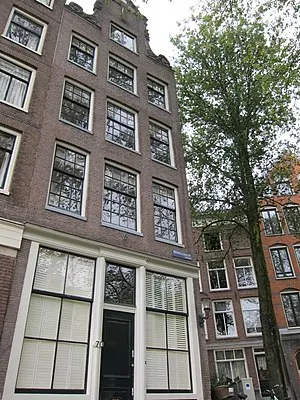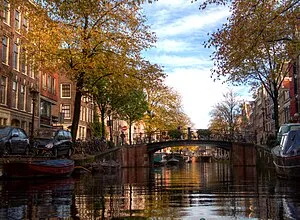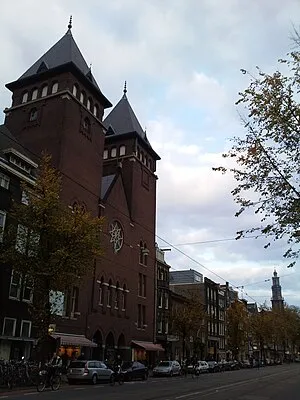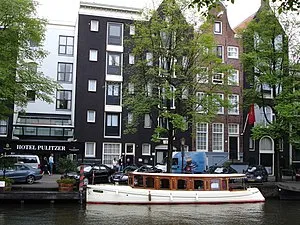



Amsterdam Unveiled: A Tapestry Tour Through Time

Tour Guide
Ryan Multilingual
Welcome to Amsterdam! On this GPS guided audio tour, we will visit 24 stops on a route of 5.04km. This tour focusses mainly on general tourism.
Locatello is an app where you can generate personal audio guided tours. Set your preferred distance, guide, language and theme, and a guided tour is created on the spot.
Walking Time
Distance
stops
Language
Tour Stops

Magna Plaza
A monumental shopping center known as Magna Plaza, located in the former Amsterdam Main Post Office building, offers a luxurious retail and office space amidst a stunning neo-Gothic and neo-Renaissance architectural design.

Singel
A a picturesque canal in Amsterdam, lined with beautiful, richly decorated canal houses built during the Dutch Golden Age.

Huis Bartolotti
A 17th-century canal house, Huis Bartolotti, is a notable example of Amsterdam's architectural heritage. Its renovation in the 1960s and 1990s preserved its original features, including intricate carvings and ornate decorations, showcasing the city's rich cultural history.

Leliegracht
A charming canal in Amsterdam's Jordaan neighborhood, the Leliegracht is one of the original canals in the city, dating back to 1612. Its buildings showcase a mix of architectural styles, including Art Nouveau, Louis Quinze, and Louis XIV.

Astoria
A unique office building with a copper-plated roof and decorative iron fencing, the Astoria is a stunning example of Nieuwe Kunst (New Art) style, serving as a former headquarters of Eerste Hollandsche Levensverzekerings Bank and international base for Greenpeace.

Huis met de Hoofden
A large canal house on the Keizersgracht with a renaissance façade and six ornaments shaped as heads, known for its association with Roman gods. It is a rijksmonument and a listed Top 100 Dutch heritage site.

Rode Hoed
A historic clandestine church, built between 1629 and 1631, serves Amsterdam's Remonstrant Protestants, featuring a neoclassical interior with two sets of galleries and a basilica form.

Prinsengracht 70, Amsterdam
A neck gable building, known to have a dormant existence, was revitalized with a mural designed and painted by The London Police in the early 21st century, featuring the characteristic smiling figures and a nod to the building's number, 70.

Amsterdam Tulip Museum
A museum showcasing the history of tulips from their origins in the Himalayas to their arrival in the Ottoman court, featuring exhibits on Tulip mania, Ottoman-style art, and bulb industry artifacts.

Anne Frank House
A war memorial and biographical museum dedicated to Jewish wartime diarist Anne Frank, preserving her hiding place and life story.

Egelantiersgracht
A canal in the Jordaan neighbourhood, the Egelantiersgracht separates the Prinsengracht and Lijnbaansgracht, with a unique slant due to its construction as part of the canal belt.

Bloemgrachtkerk
A church building from 1880, built for the Christian Reformed community, later the Reformed Church of Amsterdam, situated on the Bloemgracht in Amsterdam's Jordaan neighborhood.

Bloemgracht
A 17th-century canal in the Jordaan district of Amsterdam, constructed as part of the Third Expansion of the city.

Fatih Mosque
A historic mosque in Amsterdam, originally built as a Catholic church (St. Ignatiuskerk) in 1929, converted to a Teppich- and Musikhalle in 1974, and purchased by the Islamitische Stichting Nederland Fatih Amsterdam in 1981.

Westerkerk
A Renaissance-style church building designed by Hendrick de Keyser and completed by his son Pieter de Keyser in 1631. It is the largest Protestant church in the Netherlands and remains in use by the Protestantse Kerk in Nederland.

statue of Anne Frank
A statue of Anne Frank, a Dutch Jewish girl who died at 15 during the Holocaust, represents the symbol of its victims worldwide through her diary. Designed by Mari Andriessen in 1975, it stands tall with her hands behind her back, showcasing the life she would have wanted but never lived.

Homomonument
A cautionary monument, the Homomonument is a pink granite triangle composition with interconnected edges, symbolizing the memory of persecuted homosexuals during World War II, resistance to discrimination, and hope for the future.

Hotel Pulitzer
A five star luxury hotel consisting of 25 historic canal houses from the 17th and 18th century, merged into one and opened in 1970. The hotel has 225 non-smoking rooms and nine conference rooms.

Church of Our Lady
A Syriac Orthodox church in the centre of Amsterdam, used by both the Syriac Orthodox community and the Roman Catholic community of Opus Dei. The building has Rijksmonument status and features emphasis on hearing confessions and choral liturgy.

Kapel de Voorzienigheid
A neo-gothic chapel built in 1882 to a design by A.C. Bleys, featuring six traveeën, steunberen, and spitsboogvensters, with intricate metalwork and ribbed vaults.
Audio Preview
30 sec
Johnny Jordaanplein
A colorful square named after popular musician Johnny Jordaan, featuring a colorful hut, bronze sculptures, and statues of famous performers.

Felix Meritis
A concert hall built in 1776 in the neo-classical style, featuring a classical temple façade and an oval concert hall renowned for its acoustics, hosting many famous musicians and premieres.

Netherlands Media Art Institute
The Netherlands Media Art Institute (NIMk) was an international institution focusing on the presentation, research, and collection of Media Art. It was one of the first Dutch exhibition spaces and production facilities for artists working with new technologies.

Tabakspanden
A squatter's house in Amsterdam, originally composed of two blocks of buildings, known for its colorful facades and graffiti, including the iconic Snakehouse at Spuistraat 199.
Download App
Experience this tour and many more with our mobile app. Available for iOS and Android.
Audio Preview
Tour Map

Quick Facts
- ✓GPS-guided navigation
- ✓Professional audio narration
- ✓Offline maps available
- ✓Premium content included
Why Choose This Tour
Expert Local Guide
Narrated by Jenny Multilingual, specializing in general tourism
Flexible Timing
Take the tour at your own pace, any time of day
